President's Message
At this, the time of year for giving thanks, we thank all of you who continue to support the Henrico County Historical Society with your membership. HCHS does not receive outside funding other than from membership dues, donations and sale items. We thank you in advance for renewing your membership in January. Please invite family, friends and neighbors to join or consider the gift of a HCHS membership.
We give thanks also for those who volunteer their time on behalf of HCHS in the service of promoting Henrico County and its history. Countless hours are spent in research for families seeking information on their ancestors or information on the history of their home.
We visited one home during this year that had originally been the first Hermitage School in the Brookland District. Later converted to a residence, its history had been lost in time. It is currently being restored and will likely be submitted for inclusion on the Virginia Landmark Register.
We give thanks for the volunteers who work tirelessly on the reclamation of neglected cemeteries, with the reward of finding long lost graves. Thanks also to those who keep HCHS operational: the webmaster who keeps us up to date with technology and the World Wide Web, the meeting planners, those who produce the newsletters and publicity, those who manage HCHS financial affairs, and those who distribute information at festivals and special events, subjected to all sorts of weather conditions, I might add.
At one event in particular, the rain was predicted to clear up but didn't, and the tent leaked. Later after the sun appeared, most everything dried out. We provided a map of the region to a gentleman associated with the Virginia Film Office who was scouting locations for a movie in the making on George Washington.
Also this year, in case you didn't see the posting on HCHS Facebook page, we received the exciting notice from the Virginia Department of Historic Resources that a historic marker had been approved for "Boston" (1833-1850). What an amazing story! Considered America's first great racehorse, Boston was foaled in Henrico at a farm formerly located off Patterson Avenue. He was bred and first owned by John Wickham, who was known for representing Aaron Burr in his trial for treason. Boston's fame was legendary. His many associations included neighboring counties. His grandsire, "Sir Archy," considered America's first great stallion, was bred in Goochland County. His trainer, Col. William R. Johnson of Oakland, once represented Chesterfield County in the Virginia legislature and was known as the "Napoleon of the Turf." Boston was later put up for stud service in Hanover County.
Interesting to note, the long line of Sir Archy's descendants include Man O' War, Seabiscuit and Secretariat.
Stay tuned for interesting programming possibilities.
Happy Holidays to you and yours!
Onward to 2024!
Sarah Pace
President
>Back to Top<
December Quarterly Meeting
Come join us for our fourth meeting of the year!
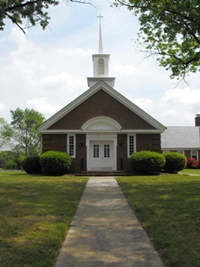
Date and Start Time:
- Sunday, December 3rd at 2:30 PM
Location:
- Lakeside Baptist Church, 7401 Woodman Road, Henrico, VA 23228
Guest Speaker:
- Robert Jones will provide a brief history of the church and Brian Treader, Ph.D., President/CEO of Lewis Ginter Botanical Garden will speak about the public garden that USA Today names the fourth best in the country.
- We'll also be electing officers.
>Back to Top<
Membership Dues Renewal
Please take a few minutes to fill out the attached envelope, write a check, stick on a stamp and join us for another year of promoting Henrico County history.
If you would prefer, you can go to the society's website at www.henricohistoricalsociety.org and pay your dues on line.
If there's no envelope here, you must be one of our Life Members, a sister organization or a recipient of a gift membership.
We thank you all for your support.
>Back to Top<
Inventive Henricoans
In 1856, Samuel Huffman looked to simplify the array of fireplace tools needed when he applied for and received a patent for his "Combined Shovel and Tongs." His compound tool, he claimed, would not cost as much as two tools and "excels in convenience."
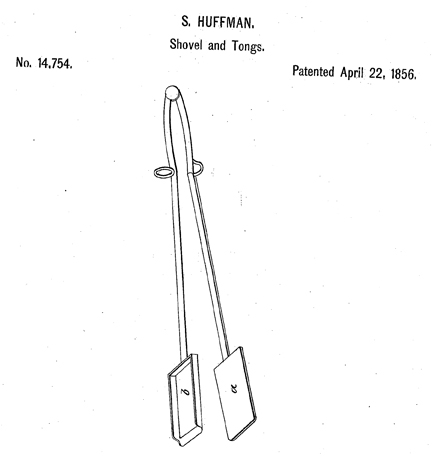
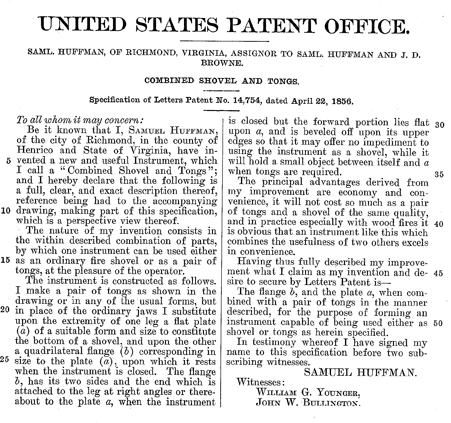
>Back to Top<
Taverns of Lower Henrico - Taking a Look at the Laws that Governed Them and the Events They Hosted
In this newsletter, we've traveled several of the major roads that ran from Richmond through Henrico County - roads that we still travel today though usually in a single trip. Earlier, slower travelers who traversed the county needed regular stopping points for rest, lodging and food for themselves and their horses; and the myriad taverns that sprang up throughout Henrico in the eighteenth and nineteenth centuries supplied that need.
In fact, taverns or ordinaries or inns became so important that Patent Yoder noted in his 1979 article "Tavern Regulation in Virginia: Rationale and Reality" (The Virginia Magazine of History and Biography) that "By the end of the Colonial era the inns of Virginia were receiving more attention from justices of the peace than were such matters as roads, land taxes, care of the poor, and general law and order."
So before taking a look at pre-Civil War taverns in lower Henrico County, it might be interesting to consider Yoder's account of the pre-Revolutionary War laws that governed their establishment and operation. The early colonial General Assembly mainly confined tavern legislation to granting licenses and fixing rates, but a 1668 law charged that ordinaries and "tipling houses" contributed to "idleness and debaucheryes," drunkenness and debt and imposed a limit of two ordinaries to counties and required them to be located near the court house. Later legislation required tavern owners to "provide for travellers good dyett, lodging and horse meate [fodder]" and fixed charges for meals, horse pasturage and liquor and gave the responsibility of fixing rates for those items to county justices.
Tippling houses where liquor by the drink was offered but not lodging, while outlawed and often condemned, seemed to continue to operate along with the "legal" taverns on through the eighteenth century up until the Revolution. And how stringent the limitation was on tavern number is unclear.
Some eighteenth century legislation forbade credit to servants and seaman, and a 1734 bill limited credit to 20 shillings a year, roughly equivalent to three hundred dollars today.
Gambling was, of course, a popular diversion, and without any defining terms, a 1705 law that forbade "gaming" on Sunday also curiously forbade "unlawful gaming" without defining the terms. A 1727 law made money paid by losers to winners recoverable at law. Later laws prohibited cards or dice, but a 1740 law excepted backgammon, chess, draughts or checkers, billiards and bowls. Enforcement, however, does not seem to have been at all strict.
While a comprehensive treatment of tavern legislation is far too extensive to attempt here, we can take a look at the taverns of Henrico County that such legislation covered. You can do by reading the next two articles below and look forward to a similar treatment of the corresponding taverns in the upper half of Henrico in the next issue.
Joey Boehling
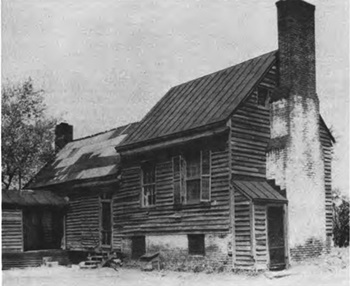
Gone and unidentified. This structure had long been gone when the County of Henrico's 1976 Inventory of Early Architecture and Historic Sites included this 1935 WPA photograph of it. While its exact site was not known, the accompanying text noted that it had stood along New Market Road and was probably built in the second quarter of the nineteenth century. (See the "Could It Be?" article below for what might be a little more information about the building and its history)
>Back to Top<
Approximate Locations and Some of the Activities Held at Taverns of Lower Henrico County
Approximate Locations of Lower Henrico's Taverns:
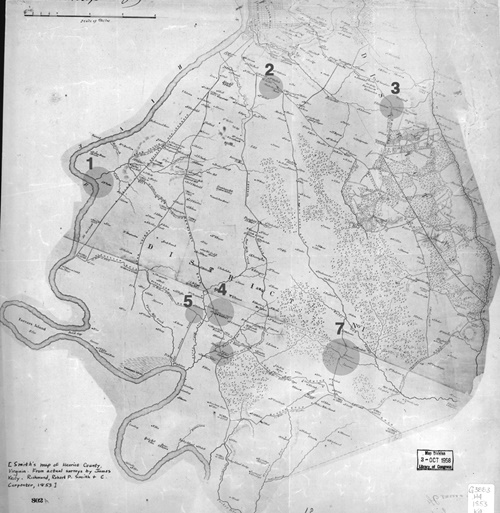
1 - Sailors Tavern
From: Daily Dispatch, 2 July 1857
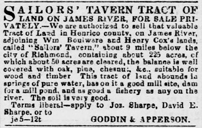
From: Daily Dispatch, 13 June 1855
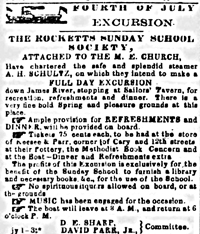
2 - White's Tavern
From: Daily Dispatch, 26 September 1856

3 - Hugh's Tavern
From: Daily Dispatch, 24 September 1856

4 - New Market
From: Richmond Daily Whig, 29 May 1843

From: Richmond Daily Whig, 12 May 1843

5 - Four Mile Creek
From: Virginia Gazette, 9 December 1773

From: Virginia Gazette, 17 January 1751
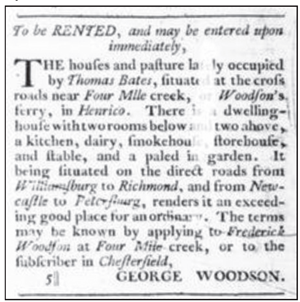
6 - Sweeney's Tavern
From: Richmond Enquirer, 18 May 1845

7 - Freeman's Tavern
From: Alexandria Gazette, 16 March 1848
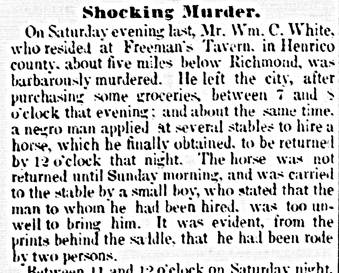
From: Richmond Enquirer, 5 February 1818

From: Richmond Enquirer, 5 February 1818
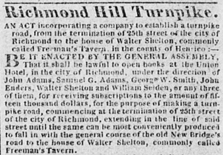
>Back to Top<
Could It Be?
Samuel Grimshaw came to Virginia from England around 1795. He worked as a farmer; and by 1816, he was operating a tavern for which he took out the insurance policy seen below on the "old Ordinary" between "the lands of Richard Randolph's to the W [and] South [and] Bailey's East," valued at 800 dollars.
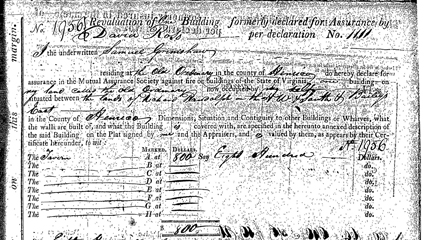
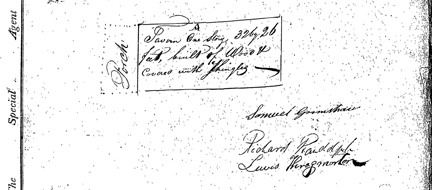
The tavern was "built of wood" and measured "32 by 28 feet." Grimshaw died in 1818. The premises were put up for auction in 1829, as advertised in the April 14 Richmond Enquirer of that year. Although the dates suggested by the Inventory of Early Architecture and Historic Sites for the tavern on page 1 are later than those for Grimshaw's, the dimensions and location of the tavern appear fairly close to those of the structure pictured. It's a tenuous but tantalizing possibility to consider.
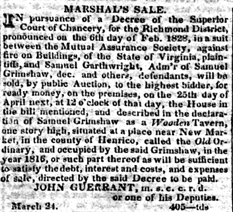
>Back to Top<
Now You Know: Handling Pressing Matters
Congratulations to Tinky Keen, Ann Jackson and Haywood Wigglesworth for correctly identifying the mystery object.

While it certainly could have been used as a fruit press as some respondents guessed, residue from pressing lard probably would have had an undesirable effect on the fruit juice. The iron press in the first image below would have been better suited for that, as the accompanying ad, in the second image below, from The Enterprising Housekeeper (1906) claims.
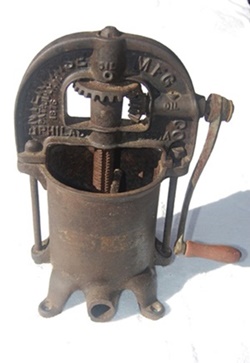
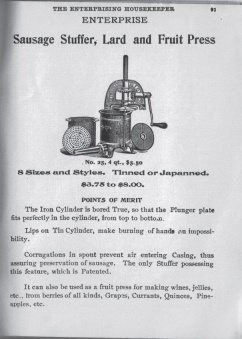
To render lard, fatty remnants from butchered hogs were slowly and carefully heated to melt the fat as seen in the photo from the Library of Congress below. Scraps were gathered as they rose to the top, placed in a burlap bag and pressed to squeeze out any remaining fat.
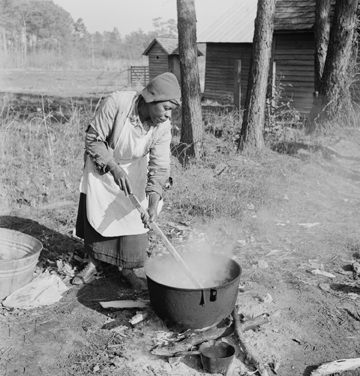
To use the leather-hinged press pictured below, the bagged remnants were placed at the fulcrum end, and the arms were squeezed together to extract the liquid.
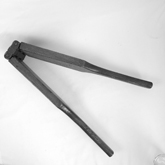
>Back to Top<
What Do You Know?
This heavy iron object is 6 " wide and 3" tall with a ring attached to the top.
Do you know what it is? Email your answers to jboehling@verizon.net.
We look forward to hearing from you.
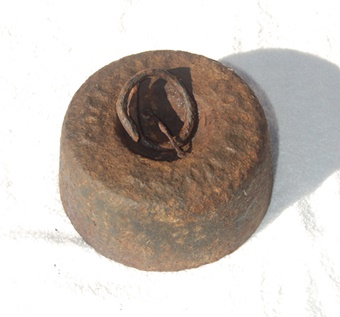
>Back to Top<
News 2023: Fourth Quarter
First Quarter | Second Quarter | Third Quarter
Home | Henrico | Maps | Genealogy | Preservation | Membership | Shopping | HCHS
|











